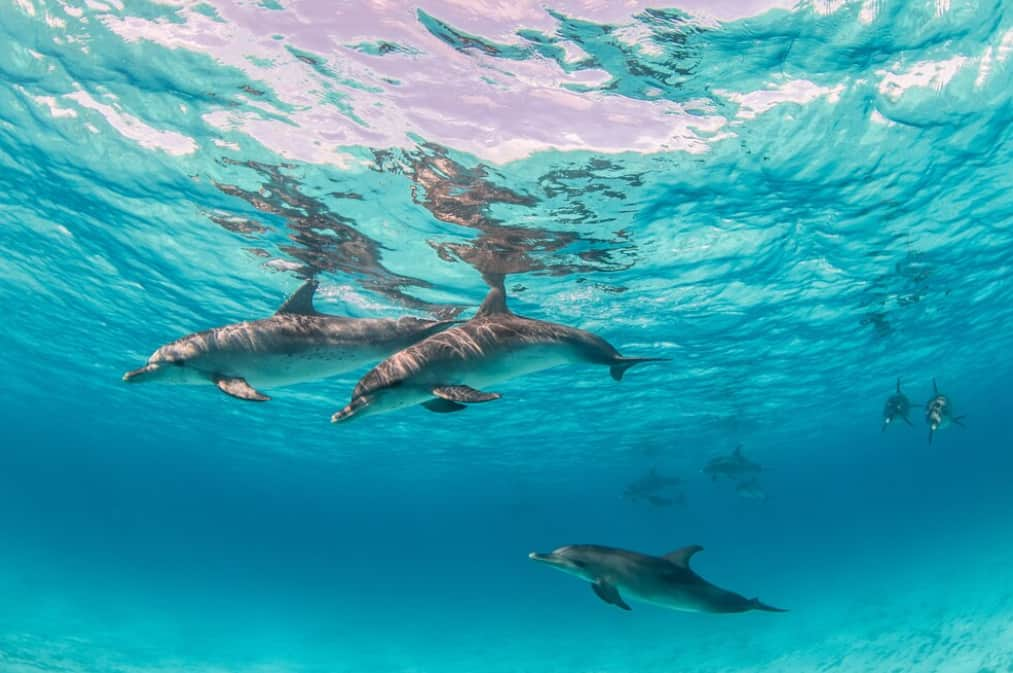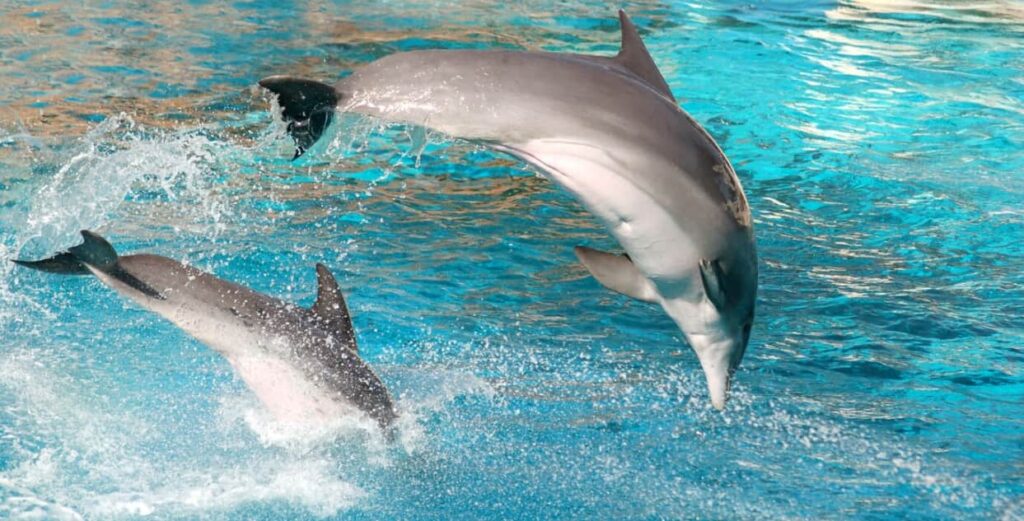Dolphins rank as the third most popular attraction for visitors to Jamaica, with their charming portrayal in advertisements fueling many tourists’ dreams. Recognized for their high intelligence, comparable to that of apes, dolphins have brains akin to humans, exhibiting complex social behavior within their matriarchal societies. They communicate with a sophisticated language, which, despite much research, remains largely untranslated by scientists. Capable of traveling 100 miles daily and diving to depths of 1,000 feet, dolphins possess acute hearing superior to that of humans, alongside refined tactile and visual senses. However, human activities such as pollution, fishing, and hunting have severely threatened their existence, exemplified by the 2006 declaration of functional extinction for the Yangtze river dolphin.
While dolphin parks present an image of joyous and friendly creatures eager to interact with humans, this often masks a grim truth. For those who truly appreciate these magnificent mammals, here are arguments against participating in swimming and playful activities with them in captivity, such as in dolphinariums. After exploring the ethical concerns surrounding dolphin attractions in Jamaica, consider learning about the natural and therapeutic wonders of Jamaica’s mineral baths.
Dietary Manipulation in Captive Dolphin Training
In captivity, dolphins are provided significantly less food than they would consume in their natural habitat. Trainers use food deprivation as a method to motivate dolphins during training, as the effectiveness of food rewards hinges on the dolphins’ hunger. Consequently, these marine animals are kept in a state of intentional hunger to encourage them to perform the entertaining tricks that spectators admire.
Reduced Longevity in Captivity for Dolphins
The reduced lifespan of dolphins in captivity is a significant concern. Despite being protected from predators, receiving regular meals, and having access to veterinary care, captive dolphins live much shorter lives than their wild counterparts. While dolphins in the wild can live for 40-50 years, those in captivity often only reach 20-25 years. This drastic reduction in lifespan can be attributed to several factors.
- One of the main issues is the stress associated with their capture and adaptation to a captive environment, which can be so severe that about 53% of dolphins captured for captivity die within the first three months;
- The causes of death in captivity range from respiratory and liver diseases to complications from medical procedures and even behavioral problems like self-harm.
These findings challenge the notion that captivity provides a safe haven for dolphins and highlight the need for a reassessment of the practice of keeping these intelligent creatures in confined spaces for entertainment and educational purposes.
Impact of Marine Entertainment on Dolphin Populations
The expansion of dolphinariums worldwide has raised serious ethical and ecological concerns regarding the well-being and conservation of dolphin populations. The practice of breeding dolphins in these facilities is fraught with challenges, including the risks of inbreeding, which can lead to genetic health problems. To supplement the captive dolphin population and meet the demands of marine entertainment, many facilities resort to capturing dolphins from the wild. This not only poses a direct threat to the dolphins captured, often leading to injury or death, but also significantly impacts the remaining members of their pods. The disruption of their intricate social structures can have profound psychological effects, manifesting in behaviors indicative of grief and confusion, thereby affecting the overall health and well-being of these highly social animals.
In captivity, the natural reproductive behaviors of dolphins are often compromised. This results in a startlingly high mortality rate among captive-born offspring, with more than 50% failing to survive past their first year. The unnatural separation of mother dolphins from their social groups in the wild prevents them from learning and practicing vital maternal skills. This lack of natural maternal education often leads to tragic outcomes, including the inability to properly care for their young, sometimes resulting in unintentional harm or death of the calves. Additionally, the early weaning of young dolphins in captivity starkly contrasts with their natural upbringing, where they would typically nurse for two to four years, thereby reducing their chances of survival and healthy development.

The cumulative effect of these practices on dolphin populations is alarming. With the ongoing removal of dolphins from their natural habitats and the challenges faced in captive breeding, certain dolphin species are increasingly becoming endangered, while others are on the brink of being classified as threatened. This situation not only highlights the immediate welfare concerns for individual dolphins but also underscores the broader implications for biodiversity and the health of marine ecosystems. The need for a critical reevaluation of the marine entertainment industry and its practices is evident, emphasizing the importance of conservation and ethical treatment of these sentient marine creatures.
Compromised Welfare in Captivity for Dolphins
The confinements of captivity fail to meet the complex requirements of dolphins, who are naturally designed for expansive ocean life. Wild dolphins cover vast distances in pursuit of live prey, a stark contrast to the restricted movement and diet of dead fish provided in artificial environments. Such limitations lead to significant stress, psychological disturbances, weakened immune systems, and physical changes due to the limited space and inadequate depth of their enclosures. The use of chlorine in tanks can cause blindness and skin deterioration, while those in sea pens suffer from prolonged sun exposure, leading to severe sunburn and related skin damage. Pathogens present in these artificial habitats or transmitted by human interaction can be fatal. The unnatural stress can trigger aggression among dolphins towards their offspring, peers, trainers, and even guests, with incidents often being underreported. Tragic outcomes have turned some dolphin trainers, including Ric O’Barry, from entertainers to advocates for their release.
Environmental Risks of Dolphin Captivity
The daily biological waste produced by captive dolphins amounts to substantial pollution, significantly impacting marine ecosystems. The nutrient-rich byproducts from dolphins contribute to the proliferation of harmful algae blooms, resulting in eutrophication, which suffocates marine life by depleting oxygen levels necessary for survival. The algae overgrowth also spells doom for coral reefs, smothering them and inhibiting their capacity to feed. The ecological damage is not localized but extends several kilometers downstream, causing widespread environmental degradation in the vicinity of dolphin enclosures worldwide.
Freedom for Captive Dolphins: Reimagining Human Interaction
While animal domestication has been part of human culture for millennia, with horses, dogs, and cats integrated into various aspects of human life, the captivity of dolphins poses a unique ethical dilemma. However, it is possible to admire these creatures without compromising their well-being. Wild dolphins often display a willingness to interact with humans, showing up alongside boats or docks, and have even been known for their acts of heroism in saving human lives.
To aspire to “become masters and possessors of nature,” as Rene Descartes suggested, is a deep-seated human trait, but it carries the weight of moral accountability. Treating dolphins with reverence due to their intelligence and social complexity is the ethical path. One practical step towards this is avoiding dolphin interaction programs and educating others about the reasons behind this choice.
For those who are eager to observe dolphins, consider these more respectful and sustainable alternatives, although they may not all be applicable in Jamaica:
- Embark on a boat tour. Dolphins, being sociable and inquisitive, often follow boats, providing natural opportunities for observation and photography. The National Oceanic and Atmospheric Administration (NOAA) recommends tour operators that engage with dolphins ethically, without encircling or disrupting their pods. DolphinSmart.org is a resource for identifying such tours;
- Use a kayak or paddleboard. These silent vessels minimize disturbance, allowing for potential close encounters with dolphins in their habitat. Paddleboarding offers a clearer view into the water and many rental shops provide introductory lessons;
- Experience virtual reality (VR). At venues like Encounter: Ocean Odyssey in New York, visitors can immerse themselves in a virtual marine world alongside dolphins and other sea life. Disney theme parks offer a VR ride that simulates an undersea journey with these marine mammals;
- Watch from the shore. Online resources can help identify beaches and coastal spots where dolphins are known to play and can be viewed from the land;
- Snorkel or dive in natural settings. Opting for small groups or local guides enhances the chance of respectful interaction with dolphins in the wild. Vigilance is necessary to avoid tours that may stress or harm dolphins by encroaching on their resting spaces or exposing them to excessive human contact.
Choosing to observe dolphins in their natural surroundings ensures that one experiences the true essence of these free and flourishing beings, living as intended in their familial social structures.
Prospects for Rehabilitation of Captive Dolphins
Rehabilitating captive dolphins is a challenging yet achievable endeavor. The process involves retraining them to hunt live prey at various times and locations, with human caretakers minimizing interaction to avoid forming attachments. Success is more likely if the dolphin is captured after learning essential survival skills, particularly if they can be released back into familiar waters. Mental resilience after enduring captivity stress is also crucial. Even dolphins born in captivity have been successfully rehabilitated and released into the wild, where they have thrived. However, some may not be suitable for release due to age, injury, or dependency, and for these dolphins, spacious sea pen sanctuaries offer a more natural environment for the remainder of their lives. With the ability to conduct comprehensive studies of these intelligent animals in their natural habitat, the justification for captivity, beyond financial gain, is increasingly questioned.
Dolphin Enclosures and Conservation Efforts in Jamaica

In Jamaica, the presence of four dolphinariums has sparked significant controversy, especially with the recent addition of an attraction at Puerto Seco Beach in Discovery Bay. The U.S. benchmark for dolphin enclosures is a minimum of 24 x 24 square feet and six feet deep, a standard Jamaica tends to follow, though the new pen in Discovery Bay reportedly has a shallow end of only four feet. Activists and marine experts are now pushing for the revocation of the dolphin facility’s license at Puerto Seco Beach, citing compelling environmental concerns. Despite protests from The University of The West Indies (UWI) Marine Lab, Jamaica Environment Trust (JET), and other local stakeholders, the government authorized the facility without a public consultation in Discovery Bay.
Declared a fish sanctuary in 2009, Discovery Bay has seen a revival in its fish populations over the years. The bay is uniquely calm and rich in marine biodiversity. It houses a marine lab that has been operational for over six decades, making it one of the most researched bays globally, with extensive literature and reef monitoring efforts. The irony of housing captive dolphins in a fish sanctuary, especially in a shallow pen, poses a direct threat to the recovering marine ecosystem. The waste produced by dolphins can exacerbate algae growth, which could deplete oxygen levels and ultimately jeopardize the sanctuary’s revival.
Conclusion
This post aims to shed light on the concerns surrounding dolphin attractions. The allure of interacting with these majestic marine creatures is undeniable, yet witnessing the cramped conditions they endure can evoke profound discomfort and prompt further investigation into the sector. Research into this area seeks to uncover facts beyond mere opinion, and the evidence points to a clear conclusion: the industry inflicts more harm than benefit. Drawing inspiration from discussions on the ethics of wildlife tourism, such as the handling of sloths in Costa Rica, the intent here is to inform about the negative impacts of supporting animal tourism. While it might appear to be a lesser concern amidst a host of pressing national issues, it remains a matter of conservation and awareness, highlighting activities that pose risks to the environment.